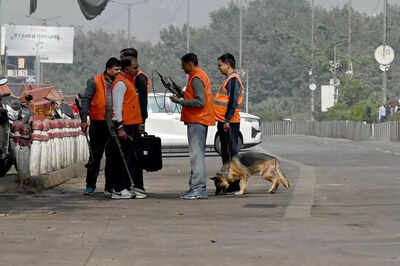Cops suspect highly unstable TATP, ammonium nitrate behind car blast | India News

New Delhi: Investigators probing Monday’s Delhi blast suspect that triacetone triperoxide aka TATP could be one of the key components of the IED that was in the car that exploded on Monday evening near Red Fort. At least two-three kg ammonium nitrate and fuel oil might also have been used along with other chemicals, which would have taken the bomb’s weight to 40-50kg, sources said.A large bag, presumably containing the improvised-explosive device, was kept on the rear seat of the i20 being driven by Dr Umar Un Nabi, who died in the blast, CCTV footage revealed earlier. The bag had occupied almost half of the rear seat, indicating the size of the IED. The impact of the blast was such that it was felt 50 metres underground and body parts were thrown in a 50-metre radius.Nicknamed ‘mother of satan’, TATP is extremely unstable, highly sensitive to shock, heat, friction and electrostatic discharge. However, it can help build “military-grade equivalent IED”, capable of impact amounting to almost 80% power of TNT (trinitrotoluene).If confirmed in the official detailed explosive report, which is yet to be submitted by National Security Guard and the forensics, it will add more clarity to the investigation, cops said. “It’s dangerous to handle in any quantity; accidental detonation during manufacturing or transportation is common,” said a senior security establishment officer.This would mean that bomb may not have needed a detonator and could have exploded due to heat or other factors. As an IED assembler, Umar knew this and that’s why he took the car to a crowded area, said sources.Police earlier suspected that the blast might have been “accidental”, a theory which now seems plausible in the wake of a blast at Srinagar’s Nowgam police station on Friday. “That’s why there were no shrapnel or pellets at the spot though car bombs don’t need them as their own parts act as shrapnels,” said an officer.TATP’s primary “advantage” is the ease of obtaining its precursor chemicals, acetone and hydrogen peroxide. They are easily available from common household products.Forensic experts said ammonium nitrate is an oxidiser and the main component in many industrial explosives, most famously ANFO (ammonium nitrate/fuel oil). Peroxides, especially concentrated hydrogen peroxide, are also powerful oxidisers.“Along with other things, explosives typically require a combination of a strong oxidiser and a fuel (a combustible material, often organic like fuel oil, aluminium powder or glycerine) to create a high-energy, detonable mixture,” said an FSL officer.Researchers have even explored hybrid explosives that combine hydrogen peroxide and ammonium nitrate as the oxidising phase, along with a fuel. “These mixtures are specifically designed to be powerful explosives, sometimes performing similarly to standard ammonium nitrate-based explosives,” said a bomb disposal squad member. “Mixing the oxidisers with with a fuel creates a highly energetic and potentially unstable material,” he added.






